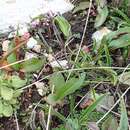Distribution
(
Inglês
)
fornecido por eFloras
Himalaya (Garhwal to Bhutan), Tibet, W. China.
- licença
- cc-by-nc-sa-3.0
- direitos autorais
- Missouri Botanical Garden, 4344 Shaw Boulevard, St. Louis, MO, 63110 USA
Cyclicity
(
Inglês
)
fornecido por Plants of Tibet
Flowering from June to August; fruiting from August to September.
- licença
- cc-by-nc
- direitos autorais
- Wen, Jun
Distribution
(
Inglês
)
fornecido por Plants of Tibet
Nardostachys jatamansi is occurring in SE Gansu, S Qinghai, W Sichuan, Xizang, N Yunnan of China, Bhutan, India, Nepal.
- licença
- cc-by-nc
- direitos autorais
- Wen, Jun
General Description
(
Inglês
)
fornecido por Plants of Tibet
Caudex erect or oblique, robust, lignified, densely covered with fibrous or lamellar remains of old sheaths. Flowering stems 5-50 cm tall. Rosulate leaves narrowly spatulate or linear-oblanceolate, 3-25 cm long, 0.5-2.5 cm wide, with 3 parallel veins, glabrous or sparsely puberulous, base attenuate into petiole nearly equal to leaf blade in length, margin entire, apex obtuse. Cauline leaves mostly 2- or 3-paired, lower ones elliptic to obovate, base attenuate into petiole; upper ones sessile, oblanceolate to lanceolate, sometimes sparsely serrate. Capitula of cymes, terminal, 1.5-2 cm broad; main inflorescence rachises and lateral rachises sometimes elongated; involucral bracts 4-6, lanceolate; bracts narrowly ovate to ovate, nearly equal to flowers in length; bracteoles 2, small. Calyx 5-lobed; lobes semi-orbicular to triangular-lanceolate, enlarged in fruit, usually ciliate. Corolla purple-red, campanulate, 4.5-9 mm, 5-lobed; lobes broadly ovate to oblong, 2-3.8 mm, outside hairy, occasionally glabrous, white villous. Stamens 4, nearly equal to corolla in length; filaments villous. Style nearly equal to stamens in length; stigma capitate. Achenes obovoid, 3-4 mm, totally or only above white hispid, to entirely glabrous; persistent calyx with lobes deltoid to ovate, 1.5-2.5 mm, obviously reticulate veined, margin usually white hispid, apex acuminate, rarely acute.
- licença
- cc-by-nc
- direitos autorais
- Wen, Jun
Genetics
(
Inglês
)
fornecido por Plants of Tibet
The chromosomal number of Nardostachys jatamansi is 2n = 16, 32 (Joshi and Joshi, 2001).
- licença
- cc-by-nc
- direitos autorais
- Wen, Jun
Habitat
(
Inglês
)
fornecido por Plants of Tibet
Growing in alpine thickets and meadows; 2600-5000 m.
- licença
- cc-by-nc
- direitos autorais
- Wen, Jun
Uses
(
Inglês
)
fornecido por Plants of Tibet
Rhizome of Nardostachys jatamansi is used to treat fever, indigestion, wound and boils, cough and sneezing, its leaf is used to treat headache and used in high altitude sickness.
- licença
- cc-by-nc
- direitos autorais
- Wen, Jun
Nardostachys grandiflora
(
Inglês
)
fornecido por wikipedia EN
Nardostachys jatamansi is a flowering plant of the valerian family that grows in the Himalayas. It is a source of a type of intensely aromatic amber-colored essential oil, spikenard. The oil has, since ancient times, been used as a perfume, as a traditional medicine, and in religious ceremonies. It is also called spikenard, nard, nardin, or muskroot. It is considered endangered due to overharvesting for folk medicine, overgrazing, loss of habitats, and forest degradation.
Description
Nardostachys jatamansi is a flowering plant of the honeysuckle family that grows in the eastern Himalayas, primarily in a belt through Kumaon, Nepal, Sikkim and Bhutan.[3] The plant grows 10–50 cm (4–20 in) in height and has pink, bell-shaped flowers.[4] It is found at an altitude of 3,000–5,000 m (9,800–16,400 ft). Rhizomes (underground stems) can be crushed and distilled into an intensely aromatic amber-colored essential oil, which is very thick in consistency. Nard oil is used as a perfume, an incense, a sedative, and an herbal medicine said to fight insomnia, birth difficulties, and other minor ailments.[5]
Phytochemistry
Preliminary research on the chemical components of Nardostachys jatamansi indicates the plant contains:[6]
In spikenard
Nardostachys jatamansi may have been used as an ingredient in the incense known as spikenard, although lavender has also been suggested as a candidate for the spikenard of classical times.[7]
References
-
^ Traditions), K. Ravikumar (Foundation for Revitalisation of Local Health; Technology (IHST)), Debabrata Saha (Institute of Trans-disciplinary Health Sciences and; Ved, D. K.; Haridasan, K. (July 16, 2014). "IUCN Red List of Threatened Species: Nardostachys jatamansi". IUCN Red List of Threatened Species.
-
^ "Nardostachys jatamansi", The Plant List, retrieved 2014-09-19
-
^ Bakhru, H. K. (1993). Herbs that heal : natural remedies for good health (3rd print. ed.). New Delhi u.a.: Orient Paperbacks. p. 117. ISBN 978-8122201338.
-
^ Deyuan Hong; Fred R. Barrie; Charles D. Bell. "Nardostachys jatamansi". Flora of China. Vol. 1. Retrieved 6 June 2020 – via eFloras.org, Missouri Botanical Garden, St. Louis, MO & Harvard University Herbaria, Cambridge, MA.
-
^ Dalby, Andrew (2000), Dangerous Tastes: the story of spices, London: British Museum Press, ISBN 978-0-7141-2720-0 (US ISBN 0-520-22789-1) pp. 83–88
-
^ Zhang, X; Lan Z; Dong XP; Deng Y; Hu XM; Peng T; Guo P. (January 2007). "Study on the active components of Nardostachys chinensis". Zhong Yao Cai. 30 (1): 38–41. PMID 17539300.
-
^ Fernie, William Thomas (1897). Herbal Simples Approved for Modern Uses of Cure. Philadelphia: Boericke & Tafel. p. 296. OCLC 1191267545.

- licença
- cc-by-sa-3.0
- direitos autorais
- Wikipedia authors and editors
Nardostachys grandiflora: Brief Summary
(
Inglês
)
fornecido por wikipedia EN
Nardostachys jatamansi is a flowering plant of the valerian family that grows in the Himalayas. It is a source of a type of intensely aromatic amber-colored essential oil, spikenard. The oil has, since ancient times, been used as a perfume, as a traditional medicine, and in religious ceremonies. It is also called spikenard, nard, nardin, or muskroot. It is considered endangered due to overharvesting for folk medicine, overgrazing, loss of habitats, and forest degradation.
- licença
- cc-by-sa-3.0
- direitos autorais
- Wikipedia authors and editors

